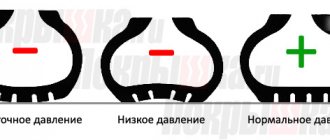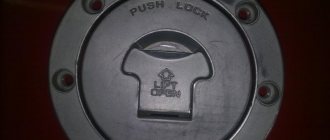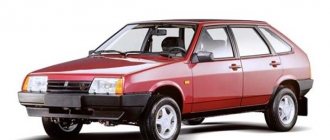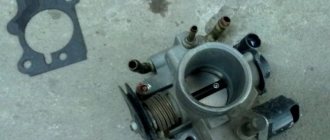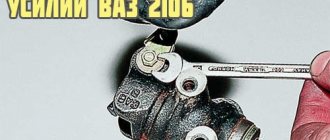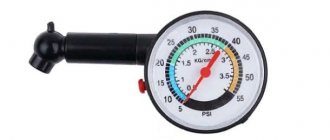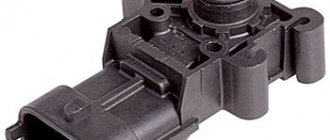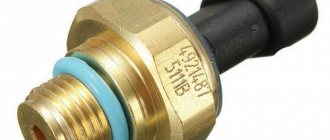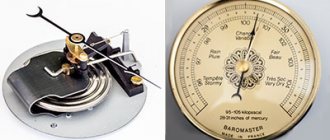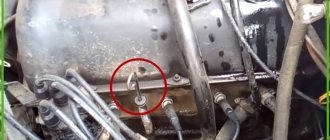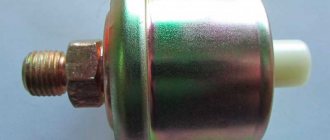The trunk of a car is a mini auto repair shop. Drivers often carry with them everything they need for urgent repairs: a set of wrenches, a jack, a tire pump, a pressure gauge to measure tire pressure. These devices are used especially often. If you notice low pressure in the tires, pump them up; large - slightly lowered.
On underinflated wheels it is easier to drive on slippery roads, the car feels softer, but it spends a lot of fuel, accelerates more slowly, the steering wheel is less responsive, and the tires wear out faster.
On the contrary, when overinflated, the car goes easier and faster, detects the slightest movement of the steering wheel, but slips on snow and mud, and may not fit into a sharp turn.
In both cases, you get a set of wrenches, a pump and a pressure gauge, and this is where the problems begin. How to correctly measure the pressure in the wheels, if some manufacturers show it in atmospheres (domestic transport), others in Bars (you can figure it out somehow), and others in incomprehensible “PSI”? PSI - what is it and how many atmospheres is it? The analysis of the issue begins with a clear concept of “atmosphere”.
How to Check Tire Pressure: Step-by-Step Plan
You should check the air pressure in your tires periodically: every time before using the car or at least once a week. The process must include mandatory rules:
- carried out on “cold” tires;
- depend on the ambient temperature.
The step-by-step action plan is as follows:
You need to check your tires before you start your trip;
- It is recommended to test the pressure on a flat surface;
- connect the pressure gauge tightly so that air does not escape to the side;
- It is advisable to take 2-3 measurements in a row and compare;
- measurements must be carried out in one unit of value, without confusing bars, atmospheres or kilopascals with each other;
- at low pressure, you need to pump up air using a hand pump or compressor, and at high pressure, bleed off the atmosphere by pressing the nipple valve;
- Finally, be sure to recheck the tire pressure.
It is important to consider that tire pressure will be different in winter. This is where the temperature effect comes into play, implying an automatic decrease in pressure from the cold
Therefore, the timing of tire checks should be shortened to the maximum at this time of year - it is better to check daily. Here's how tire air pressure is typically monitored during the winter months:
- when measuring indoors, it is taken into account that outdoor pressure will drop by 0.1-0.2 atm;
- When taking measurements with a loaded trunk, an allowance is made for the increase in mass - the pressure should be slightly increased, especially on the rear axle.
In winter, it is not recommended to keep your tires half-flat, even when driving at high speeds. However, some motorists deliberately flatten their tires, supposedly providing a comfortable ride. Such actions lead to at least five dangers:
- the damping index deteriorates, resulting in damage to the disk;
- the braking distance increases, which in winter threatens an emergency situation;
- increased tire wear due to uneven aging of the tread;
- the pressure decreases sharply, which at high speed leads to disaster;
- the tire comes off the rim.
Now about what can happen in the opposite case, when the pressure parameters are too high:
- uneven asphalt, holes and potholes are felt much more strongly;
- there is a risk of sudden abrasion of the rubber;
- the percentage of rubber contact with the road surface decreases, which prevents the tread from operating normally;
- the car's directional stability decreases.
In cities and large populated areas where travel routes are treated with chemicals, tire pressure is checked as usual, regardless of the time of year.
Pressure control must be carried out correctly, taking into account all recommendations. A step-by-step work plan is the only correct, competent solution that allows you to avoid mistakes. You can’t check the pressure the old-fashioned way, by kicking the wheel, “by eye.” In this way, it will only be possible to detect a camera that is too deflated. You should also not hope that you can determine the incorrect pressure by the behavior of the car on the road - only experienced motorists can do this, and even then not always!
As a result, the correct pressure is the optimal balance of such indicators as comfort, safety, good handling and minimal fuel consumption.
Modern luxury cars are equipped with automatic control systems - pressure indicators are displayed on the computer display. On budget and older foreign cars, you can find out about problems with pressure by the blinking of a special indicator - the immobilizer on the instrument panel. Our automakers have placed the responsibility of checking tires on the shoulders of the drivers themselves. If you don’t have a pressure gauge at hand or the indicators are in doubt, you can always get professional help from a tire shop.
FAQ
1 bar how many atmospheres?
To get an approximate result of how many atmospheres are in one bar, you need to divide the pressure value by a factor of 1.013. That is, 1 bar is 0.98 atmospheres
. Therefore, when converting one unit of measurement of small pressure (up to 10 bar) to another, it is generally accepted that 1 bar ≈ 1 atm. This ratio in calculations will give an error not exceeding 2%.
- To find out how much bar is in one megapascal, it is enough to multiply the pressure value expressed in MPa by 10. That is, 1 MPa = 10 bar
1 MPa is how many KGS cm2?
To convert one MegaPascal to a pressure value expressed in kilogram-force per square centimeter, it is enough to multiply the MPa value by 10.197. Thus 1 MPa = 10.197 kgf/m²
Tire pressure measurement
To measure the air pressure in your tires, you need to use a tire pressure gauge. He can be:
- mechanical - characterized by maximum reliability, simple design and low cost. The disadvantages include the need to double-check the readings and the high sensitivity of the device to moisture;
- rack and pinion - a fairly cheap and simple option from the point of view of operation; excessive fragility is considered a significant disadvantage;
- electronic - a high-precision device with a long service life, which justifies the high cost.
Measurements are taken with cold tires, before leaving the garage or parking lot.
The measurement procedure is as follows:
- The pressure gauge readings are reset to zero.
- The safety cap (if present) is unscrewed from the wheel nipple.
- The pressure gauge is attached to a nipple, which must be pressed slightly to release the air.
- Wait until the meter needle stops.
As a rule, the error of pressure gauges is approximately 0.2 kgf/cm2. Measurements are taken with cold tires, before leaving the garage or parking lot, since with warm tires the distortion of indicators can be up to 10-20%.
It is ideal if the pressure gauge readings are checked daily, but in practice this is not always possible. Measurements must be taken every 7-10 days (in winter - every 3-4 days), as well as when:
- sudden changes in ambient temperature;
- a sharp deterioration in controllability;
- before a long trip.
Nuances of translation in different units
On the body of many “pure Europeans” the value in psi is already indicated, which the manufacturer targets. For cars of foreign brands that are assembled on our territory, the technical atmosphere indicator applies. So, the approximate ratio will be as follows:
1 Atmosphere contains 14 PSI.
Confusion may arise if the tire or compressor (by the way, which one is better to choose, read here) shows the acceptable values in the BAR. In fact, 1 Bar is approximately equal to 1 atmosphere, so you can use this ratio. For those. For those who are interested in how this all turned out mathematically, here is a simple proof:
- 1 pound contains approximately 0.453 kilograms;
- at the same time, in every square inch there are 6.4516 square centimeters.
We find that one PSI will contain 0.07 kg/cm2, or in each atmosphere, on the contrary, there will be approximately 14 PSI. Despite the fact that such designations may not be entirely familiar to a Russian driver, translation is usually not difficult. The need may arise when purchasing car tires or devices for inflating air. At the same time, Chinese manufacturers often indicate several designations in their products for convenience.
Units
Before figuring out what the pressure should be, you need to understand in what units it is measured.
Tire pressure significantly affects the safety of movement in a vehicle and the service life of tires.
In all Soviet-made cars, it is customary to measure it in kilogram-force per square centimeter (kgf/cm2) or technical atmospheres. On imported vehicles, units of measurement such as bar (bar) or PSI (pounds per square inch) are often found. Sometimes pressure is measured in kilopascals (kPa), but it is worth remembering that manufacturers use this measure to indicate the maximum permissible value. Converting these units from one to another is quite simple: 1 bar = 0.980655 atm; 1 PSI = 0.068 atm; 1 atm = 14.706 PSI 1 kPa = 6.89476 PSI 1 atm = 101.325 kPa.
If it is difficult to translate how many atmospheres are in a kilopascal or other unit of measurement, you can use a special convector program for your mobile phone.
What units of pressure are most often converted?
When working with imported cars, you have to deal with completely unusual units, especially pounds per square inch ( psi ). Here it is difficult for an unprepared person to quickly figure out how much it will be in familiar bars ( bar ) or atmospheres ( atm ).
Even if everything is clear to him with a pound and an inch, then with their combination he gets into a dead end. You have to look into tables or specialized calculators. The situation with other units is no better.
How many bar is 1 MPa
The bar is a non-systemic unit, but since it is approximately equal to one atmosphere, no difficulties arise, and minor errors almost always do not affect anything. But to be precise, a bar is ten newtons per square centimeter, that is, 0.1 megapascals ( MPa ).
Because pascal is one newton per square meter, a purely systemic unit in the international SI system. This means that there are exactly 10 bar in one MPa.
How many bars in 1 atmosphere
Strictly speaking, the atmosphere, as a unit of measurement of pressure, can be technical or physical. The technical one is exactly equal to one kilogram-force per square centimeter ( kgf/cm2 ), the physical one is a little more due to the inequality between the kilogram-force and ten newtons.
The difference is due to the fact that the connection between newton and kilogram-force is derived through the acceleration of gravity at sea level, and this is not exactly 10, but approximately 9.87. That is, in 1 technical atmosphere ( 1 atm ) there is approximately 0.98 bar , and in a physical atmosphere ( 1 atm ) – 1.013 bar . Such errors can always be neglected, as can the difference between both atmospheric units.
How many bar in kilogram-force
Kilogram-force per square centimeter ( kgf/cm2 ) is the technical atmosphere. Taking into account the above, it is easy to understand that one bar is 1.0197 at. That is, it is about two percent more. This means kilogram-force per square meter. cm will be 0.98 bar. For automotive technology, we can say that these are one and the same. Normal atmospheric pressure.
Sources used:
- https://autorealm.ru/kak-perevesti-psi-v-atmosfery/
- https://dic.academic.ru/dic.nsf/ruwiki/261258
- https://raznisa.ru/raznica-mezhdu-psi-i-bar/
- https://m.etlib.ru/calc/pressure-transfer
- https://autovogdenie.ru/perevod-davleniya.html
Atm to PSI conversion explained; PSI to Bar; PSI in kg/cm²
Translation may not be required if the driver has a foreign car at his disposal - on the bodies of foreign cars, the pressure is indicated in PSI, the most common indicators for passenger cars are 29 and 35. However, “Russified” foreign cars that are produced in the CIS, come out with the “technical atmosphere” indicator. A striking example is Renault Logan or Kia Rio. The most convenient way is to convert to one indicator, which is 1 Bar (a unit of pressure and gravity):
- If you convert 1 Bar to 1 Atmosphere, the figure will be approximately the same
- When converting PSI to Bar, you get the following ratio: 1 Bar = 14 PSI
- 1 Atmosphere equals 14 PSI
Video about optimal tire pressure
In the case when pressure is measured in Bar on pneumatic pumps, you need to remember that this indicator corresponds to the generally accepted Atmospheres in the CIS, and the minimum spread is not taken into account.
Conversion can be made from PSI to kg/cm²:
- 1 pound equals 0.453 kilograms. This is not an exact figure, but for technical work it is suitable
- 1 square inch is equal to 6.4516 cm²
Having these two indicators, you can find out how many kg/cm² are in PSI. Result: 1 PSI = 0.0702 kg/cm²
Accordingly, 20 PSI will be equal to 1.4 kg/cm²
These two indicators have a ratio: 7.03*10-2
An alternative indicator of tire pressure in Europe is PSI.
In order not to waste time calculating the proportion, you can use a simple table that shows the values for the pressure in the tires of a car - here the driver will find various options for measuring pressure. There are also convenient unit calculators where you can also convert Bar to PSI. If you want to find out how many atmospheres there should be in a particular tire, you can perform an independent calculation, the reporting point will be 1 PSI = 0.07 Atm.
Sometimes it may be necessary to convert PSI to kg/cm² or vice versa. The calculation here will be more complicated, so it will be easier and more rational to use a ready-made table, which contains the main indicators for cars, bicycles, motorcycles and mopeds. Instead of Bar, you can substitute atmospheres - the indicator will not change. These ratios and the table should give a clear answer to the question: “how to convert PSI to Atm?”
| Psi | kPa | kg/cm2 | bar |
| 20 | 138 | 1.4 | 1.4 |
| 21 | 145 | 1.5 | 1.4 |
| 22 | 152 | 1.5 | 1.5 |
| 23 | 159 | 1.6 | 1.6 |
| 24 | 165 | 1.7 | 1.7 |
| 25 | 172 | 1.8 | 1.7 |
| 25.5 | 176 | 1.8 | 1.8 |
| 26 | 179 | 1.8 | 1.8 |
| 26.5 | 183 | 1.9 | 1.8 |
| 27 | 186 | 1.9 | 1.9 |
| 27.5 | 190 | 1.9 | 1.9 |
| 28 | 193 | 2.0 | 1.9 |
| 28.5 | 197 | 2.0 | 2.0 |
| 29 | 200 | 2.0 | 2.0 |
| 29.5 | 203 | 2.1 | 2.0 |
| 30 | 207 | 2.1 | 2.1 |
| 30.5 | 210 | 2.1 | 2.1 |
| 31 | 214 | 2.2 | 2.1 |
| 31.5 | 217 | 2.2 | 2.2 |
| 32 | 221 | 2.2 | 2.2 |
| 32.5 | 224 | 2.3 | 2.2 |
| 33 | 228 | 2.3 | 2.3 |
| 33.5 | 231 | 2.4 | 2.3 |
| 34 | 234 | 2.4 | 2.3 |
| 34.5 | 238 | 2.4 | 2.4 |
| 35 | 241 | 2.5 | 2.4 |
| 35.5 | 245 | 2.5 | 2.4 |
| 36 | 248 | 2.5 | 2.5 |
| 36.5 | 252 | 2.6 | 2.5 |
| 37 | 255 | 2.6 | 2.6 |
| 37.5 | 259 | 2.6 | 2.6 |
| 38 | 262 | 2.7 | 2.6 |
| 38.5 | 265 | 2.7 | 2.7 |
| 39 | 269 | 2.7 | 2.7 |
| 39.5 | 272 | 2.8 | 2.7 |
| 40 | 276 | 2.8 | 2.8 |
PSI Conversion Table
Converting American standard units into Bars, which are more understandable to a Russian motorist, is usually necessary when you are not accustomed to such numbers, but later you quickly begin to understand what the pressure gauge approximately shows. In addition, on the Internet you can find many ready-made tables with calculations, and pound/in² is converted not only to Atmospheres, but also to kPa, Bar, kg/cm².
Someone might argue that atm and bar are the same value, but to be precise, it must be said that there is still a slight difference in them. It’s just that many round the values for ease of calculations; car enthusiasts are well aware that when measuring tire pressure, it is not so important to count thousandths and hundredths; it is enough to use units and tenths in the readings.
Typically, values are rounded to tenths; in such numbers, car pressure is measured not only in the wheels, but also in the fuel and oil system. Many measuring instruments have several scales, and there is no need to convert readings from one number system to another. From such a pressure gauge it is immediately clear that 30 psi is equal to approximately 2.1 bar, and 35 psi is a little less than three Atmospheres. The scales can be designed to cover a wide range of measurements, with standard household tire pressure gauges typically indicating an upper limit of 60 psi. By the way, the scale in the lbf/in² standard often indicates not the letters psi, but the abbreviated names of pounds and inches in the form “lbf/in²”.
Bar and psi – tire pressure. Measurement and conversion of quantities
All owners of wheeled vehicles - motorists, motorcyclists and cyclists - have to monitor tire pressure. For each type of transport there is a range of optimal pressures, which, among other things, can be found out by the rubber markings.
Most often you have to deal with bar or psi units. Pressure in inches per square meter (psi) is used to mark tires manufactured in England and America. Ba r is a unit for measuring pressure, adopted in European countries, including ours. It is almost equivalent to the technical atmosphere.
Most modern pressure gauges have a double scale, on which you can immediately see the pressure in bar and psi. There are also electronic pressure gauges for motorists; they can select the desired display mode. But manually converting psi to bar and back has to be done quite often, since not every car enthusiast has measuring instruments.
For a single calculation it is enough to use the equality:
1 psi = 0.069 bar
1 bar = 14.504 psi
Precision to three decimal places is not usually required. In most sources you will find that 1 bar ~ 15 psi. But the higher the pressure, the greater the error in calculations according to this approximate equality. Therefore, multiplying by 14.5 is the best option.
You can also convert pressure from bar to psi using special electronic pressure gauges, which are sold in stores for car enthusiasts. But if there is no such device, and the conversion of psi units to bar and back needs to be done frequently, it makes sense to make a table. In garages they use tables with value increments of 1 and 0.1 bar or from 5 to 15 psi. And if you have access to the Internet, the easiest way to convert the value is using a search engine calculator.
Measurement errors
Tire pressure is quite dependent on temperature, so the pressure gauge readings will differ in the warm and cold seasons, even if the same volume of gas is pumped. The tire also heats up during driving, due to friction with the road surface.
Measurements are usually carried out “cold”, when the car has driven no more than 3 km at low speed or has stood for at least 2 hours. When the condition cannot be met, you need to subtract 0.3 bar ~ 4.5 psi from the received readings. Pressure measured in winter and summer can differ much more: for every 5 degrees Celsius drop in temperature, the reading decreases by 1 psi.
A car or motorcycle tire naturally loses about 1 psi each month (a bicycle tire's pressure drops by as much as 15 psi). Thus, with a gradual increase in the average monthly temperature in the spring, it is often not necessary to inflate car tires. And in the fall and especially during a sharp cold snap, this is a guarantee of safety on the road.
It is sometimes difficult for a non-professional to determine the exact pressure, since in mechanical instruments an error almost always appears. Now you can buy pressure gauges with “smart” microcircuits that make corrections for temperature. Whether it’s worth purchasing a multifunctional device, trusting your intuition or the skill of a service station worker is up to you to decide. The main thing is that the tire pressure is suitable for a comfortable and safe ride.
A little about atmospheres
As already mentioned, in most cases the pressure unit is the atmosphere. But not everyone understands what it even means.
The atmosphere is called pressure, which is equal to 1 kilogram per cm2. This is about 0.1 MPa (megaPascal).
In relation to the atmosphere, there are 2 standards:
- Technical. Denoted as at or at. In the technical case, 1 atm corresponds to 735.56 mmHg.
- Physical. This is already atm or atm. The difference is small since it is 760 mmHg.
In relation to the pressure in the wheels of a car, it is customary to equate the technical and physical atmosphere.
Do not forget that the difference between 1 atm and 1 bar is also insignificant. The latter corresponds to 750.06 mm. mercury column. Because of this, 1 atm = 1 bar. For motorists, the slight error between two units of pressure measurement is not taken into account. This will not affect the condition of the tire in any way.
How to measure tire pressure: tools
The following devices and systems are known to measure tire pressure today:
- digital pressure gauges - they are the most accurate, err by only 0.055 bar;
- mechanical-electronic pressure gauges with an arrow - they are also often used;
- A universal method is to equip the machine with a standard TPMS system.
In the latter case, pressure control will be carried out automatically; the driver will only need to respond in a timely manner to the signs given by the device when there is insufficient air in a particular tire.
For those who have realized the benefits of professional service, specially equipped tire service stations with digital inflation guns are offered. Here, errors in measurements are reduced to zero. Experienced mechanics quickly determine if the valve is faulty, replace it in a timely manner, and then carry out all the necessary calculations.
It is advisable to check the air in the tires with a pressure gauge “when the tires are cold,” since “hot tires” can spontaneously increase the pressure. “Cold” are the wheels of a car that have traveled no more than 1.6 km after a long stop.
How to count as quickly as possible
Despite some errors in calculations during translation, they are so insignificant that they do not cause any inconvenience in practice. To measure pressure, it is quite enough to use whole numbers and decimal parts. Most household pressure gauges are limited to a maximum of 60 PSI. Now you have enough knowledge and understanding. How do the various units of measurement that may be associated with tire pressure relate to each other?
As we said above, if your car tire or pump has the designation described above, then you can use a regular calculator for the translation, using the above mathematical calculations as a basis. Or you can resort to using special online calculators or ready-made tables with the values given in them. In these ways, you can make transfers from one unit of measurement to another, or vice versa. The ratios will be fair in any case and are suitable for cars and trucks, buses, and motorcycles. With this, we’ll say goodbye, dear car enthusiasts, and subscribe to Andrey Kulpanov’s blog to keep abreast of the most interesting news. Bye!
Views:7558
3likes
Unit conversion
In fact, the translation between atm and PSI does not cause any great difficulties. In this case, there is no need to be a mathematical genius and carry out complex calculations.
If you want to ensure the correct pressure in your tires, but you are not sure how many atmospheres correspond to PSI, there is one simple rule you can use.
To convert PSI to bars or atmospheres that are more familiar to us, it is enough to divide this value by 14.
Suppose your technical documentation indicates PSI units, but the tire pressure can be created by relying on a pressure gauge with a bar measurement unit. Everything is elementary. You take the PSI that the car manufacturer specified in the regulations and divide it by 14.
Let's assume you know exactly how much PSI, according to technical regulations, should be in properly inflated tires of your car. The documentation states that the tires should be inflated to 26 PSI. Just divide 26 by 14 and you get the required value. As a result, we have an output of 1.8 atmospheres or bar. There is no fundamental difference between the last two units.
How to check tire pressure - buy a pressure gauge!
How to determine tire pressure if there is no gas station or service station nearby? You can evaluate this parameter without a pressure gauge, focusing on the appearance of the tread after a long trip on a dry and relatively clean surface. Such conditions are rare, but still - if both sides of the tread are clearly darker than the center, this means that the pressure is too low.
However, only a special pressure gauge, which is equipped at all vulcanization stations, service stations and gas stations, will show you true indicators. To measure the pressure, you simply insert the end of the hose into the nipple. However, before checking the tire pressure, you should let the car cool down after driving. For example, if you stop at a gas station and decide to pump up your tires, wait at least 15 minutes before doing so. Tire pressure should be checked at least once every two weeks or after every 2,000 km.
How to convert pressure from PSI to atmospheres + table
Every motorist has at least once encountered under-inflated or over-inflated tires. In the first case, fuel consumption increases, the car responds to the steering wheel more slowly, accelerates more slowly, and tire wear accelerates. At the same time, the car’s maneuverability in snow and mud improves, and the car feels softer. In the second case, the car reacts faster to steering movements, accelerates more easily, but is less stable in high-speed turns and when driving over rough terrain. Each automaker recommends a certain tire pressure for their cars, at which they behave most correctly. At the same time, some indicate pressure in atmospheres, others in bars, and others in psi. In this article we will tell you what is the difference between these units of measurement and what is the relationship between them.
What is atmosphere
Atmosphere refers to a pressure equal to 1 kg per cm², or approximately 0.1 MPa (megaPascal). At the same time, there are two atmospheric standards - technical (at, at) and physical (atm, atm), the difference between which is very small. For example, one technical atmosphere corresponds to 735.56 mmHg, while 1 atm corresponds to 760 mmHg. When applied to automobile wheels, it is generally accepted that the technical atmosphere is equal to the physical atmosphere. And approximately the same corresponds to 1 bar (750.06 mmHg).
What does PSI mean?
Psi refers to pressure in pounds per inch² and 1 psi corresponds to 51.715 mmHg, which is approximately 14 times less than the atmosphere. This definition of pressure is accepted in countries that live according to the inch (English) system of measures, because in those countries few people know what 1 atmosphere is equal to.
Converting from PSI to atmospheres or bar
There is a simple rule that will help you convert pressure from psi to atmospheres or bar with acceptable accuracy. To do this, the pressure in psi must be divided by 14. The resulting result will be the pressure in bars or technical (physical) atmospheres. For many cars, the normal pressure is 26 psi, that is, 1.8 atmospheres. In summer, you can increase the pressure to 28–29 psi, which will be 1.9–2.0 atm. In winter, if there is snow or ice on the roads, it is advisable to reduce the tire pressure to 23–25 psi, which corresponds to 1.6–1.7 atm.
Correct tire pressure is one of the keys to safe and economical driving, but it is not always possible to use a compressor that displays the pressure in usual values. After reading this article, you learned how to convert pressure from psi to atm, so you can always maintain optimal tire pressure.
Pneumatic and electric tools for cars
There are various tools that are designed to handle pressures greater than 60 lbf/in², for example let's take a 300 PSI car compressor. The electric pump operates from the vehicle's on-board 12-volt network, with its help you can quickly and easily inflate a tire on the road, check the tire pressure, the power cord is connected to the cigarette lighter socket. This device is equipped with a convenient carrying handle, it also has a flashlight, and the compressor is convenient to use at any time of the day. The maximum value on the pressure gauge scale is 300 lbf/in², which, translated into our usual system of readings, turns out to be almost 20.5 Atmospheres. The power cord of the device is so long that it is enough to place the compressor next to any wheel of the car. It's likely impossible to get an impressive 20 Bar from the device, but the numbers on the scale are impressive.
The Tornado AC-580 compressor is declared by the manufacturer more modestly, its scale is designed for pressure up to 150 PSI, but with the help of this device you can inflate the tire not only on a passenger car, but also on a light-duty truck with a load capacity of up to one and a half tons (for example, on a Gazelle "). The tire compressor is capable of producing up to 30 liters of compressed air per minute, operating continuously for up to 20 minutes, the cable length is 1.9 m. Tornado is also powered from the cigarette lighter socket, the device has very compact dimensions and low weight (1.5 kg).
Various air impact wrenches operate on compressed air, for example, model JTC-3921. The tool is designed for operating pressure from 90 to 120 PSI, most often used in car repair shops for quick and convenient disassembly and assembly of components and assemblies.
The impact wrench produces a maximum torque of 624 Nm and weighs only 2.65 kg. The powerful metal body ensures a long service life of the tool; the maximum rotation speed reaches 8000 rpm.
Related articles:
- New MTPL forms from July 1, 2021 Lately, forgery of auto insurance policies has been common, and in order to solve this problem, it was decided to introduce new MTPL forms from July 1, 2016. New OSAGO forms with 1 […]
- Buying a new foreign car up to 600 thousand rubles In this article we will find out which new foreign cars up to 600 thousand rubles are sold in the Russian Federation in 2021, what may be included in the package for this money. For the last […]
- Replacing spark plugs for Nissan Qashqai 1.6 and 2.0 The first sign that will tell you that you need to replace spark plugs for Nissan Qashqai 1.6 is insufficient engine traction when driving, dull sounds in the engine and problems with ignition. […]
Checking tire pressure - what does “underinflation” affect?
Many drivers buy a pressure gauge for “home” use so as not to have to look for how to check tire pressure at the most inopportune moment. And this is a very correct step - it’s unfortunate, but at different service stations and gas stations, pressure gauges may show different data. Therefore, every time after inflating the wheels, it is worth checking the pressure with your own pressure gauge, and, based on your own driving sensations, determine the ideal pressure value. For these reasons, it is recommended to inflate the wheels in one place where you already know the errors of the pressure gauge.
Correct pressure is a very relative concept. For example, a tire manufacturer recommends a pressure of 2.3 atmospheres, arguing that lower pressure increases tire wear. However, this advice is relevant for European roads, but for our potholes and potholes, such high tire pressure can result in the loss of dental crowns - the shaking will be incredible. This is not to mention the suffering of the car's suspension. So our drivers have to look for compromises between tire wear and the condition of the car as a whole, and underinflated wheels are one of these solutions.
It should be borne in mind that insufficient tire pressure increases the braking distance and also increases fuel consumption by 5–10%. Please note that the standards that are usual for an old car may not be suitable for a new car at all, so it is better to find out unofficial information from the employees of a service center or service station - they should know what problems drivers come to them with every day.
What does PSI mean in text
In sum, PSI is an acronym or abbreviation word that is defined in simple language. This page illustrates how PSI is used in messaging and chat forums, in addition to social networks such as VK, Instagram, Whatsapp and Snapchat. From the table above, you can view all the meanings of PSI: some are educational terms, others are medical terms, and even computer terms. If you know another definition of PSI, please contact us. We will enable it during the next update of our database. Please be aware that some of our acronyms and their definitions are created by our visitors. Therefore, your suggestion for new abbreviations is welcome! As a return, we have translated the acronym of PSI to Spanish, French, Chinese, Portuguese, Russian, etc. You can further scroll down and click the language menu to find meanings of PSI in other 42 languages. ‹ PYR
QAX ›
How to easily convert PSI to atmosphere
Replacing and inflating wheel tires is one of the constant problems of car enthusiasts. When purchasing a pump in a store, the buyer is confused at the sight of the incomprehensible “PSI” symbol. Some people consider this to be the name of the equipment brand, which is not true. So what does the “PSI” sign on a car pump mean? What is the compliance with 1 PSI atmospheres?
Russian and European pressure designation
Atmospheric pressure (Atm) shows the force of an air column per unit surface area. The symbol of this physical quantity is 1 Atm, or 1 kgf/m2. For chambers of different diameters, the recommended pressure will vary significantly.
We are used to measuring this value in atmospheres (Atm), however, in European countries the symbol “PSI” is used to indicate pressure. Thus, Psi is an alternative to familiar atmospheres. If you see “300 PSI” on the compressor, we are not talking about the brand of the product, but about the pressure. Now we have to convert PSI into atmospheres.
Understanding the symbols
In European countries this value is calculated in pounds per inch squared. Russians don’t know either inches or pounds. To make this task easier, let’s use the usual Bars. The unit of pressure and gravity The bar corresponds to a unit of technical atmosphere, or 14 Psi. That is, 14 Psi will be equal to 1 Bar or one atmosphere.
If the instructions for the machine indicate a recommended pressure of 30 Psi, then it is necessary to divide the number 30 by 14. As a result, we get approximately 2 Atm. Using this calculation formula for converting PSI to atmospheres, you can always find out the exact value in familiar units.
How to check tire pressure.
Operating a car with inappropriate tire pressure can lead to unpleasant situations on the road surface. This value should be checked using a pressure gauge before the car leaves the garage, that is, in a cold chamber.
a) Underinflated tires
Underinflated wheels will lead to premature tire wear, as well as increased fuel consumption. Constant deformation of the tire increases rolling resistance and increased heating of the rubber. Underinflated wheels lead to:
• poor controllability; • directional instability; • increased tread wear.
b) Overinflated tires
Increased tire pressure worsens the adhesion of the treads to the road surface, which impairs vehicle controllability. The working life of the suspension is also reduced due to the increased load on its elements. Over-inflated tires lead to:
• tossing the car on bumps; • rupture of the wheel chamber; • premature wear of the rubber.
If with an underinflated tire the tread wear occurs along the edges, then with an overinflated tire it occurs in the center.
Bottom line.
To calculate the required pressure value, you can use an online converter. However, the necessary information may not always be available. Therefore, remember the formula: 1 Atm equals 14 Psi.
How to use an online calculator
In order to use the instant conversion of one pressure value to another and find out how much bar will be in MPa, kgf/cm², atm or psi you need:
- In the left list, select the unit of measurement with which you want to convert;
- In the right list, set the unit to which the conversion will be performed;
- Immediately after entering a number in any of the two fields, the “result” appears. So you can convert from one value to another and vice versa.
For example, the number 25 was entered into the first field, then depending on the selected unit, you will calculate how many bars, atmospheres, megapascals, kilograms of force produced per cm² or pound-force per square inch. When this same value was put in another (right) field, the calculator will calculate the inverse ratio of the selected physical pressure values.
Verification methods
Firstly, you should check your blood pressure regularly, at least once every two weeks. To determine it without any instruments, you should look at the tire tread after a trip. If the tire pressure is insufficient, the edges of the tire will be darker than the middle. This occurs due to the deformation of the tire under the weight of the car. How can you accurately measure tire pressure?
Pressure gauges - measuring instruments are mechanical and electronic, with varying degrees of error (usually no more than 0.2 bar). In addition, the car must have a pump or compressor, which is usually equipped with built-in pressure gauges that measure current performance. Please note that pressure gauges do not always accurately display actual values. If you suspect that the device incorrectly displays the pressure in your car’s tires, you need to double-check its values with another pressure gauge or visit gas stations, which always have accurate measuring instruments.
Why do we need pressure measurement units?
In the process of servicing vehicles, especially foreign-made ones, one has to deal with how many atmospheres (BAR) is the pressure in the wheel tires. Many drivers always have a pneumatic compressor at hand, often made in China. You can see the psi designation on it, for example, 200 or 300 psi. This is the maximum value for which the equipment is designed - this is what is used in most European countries.
Domestic car enthusiasts are more familiar with the traditional “atmospheres” in which it was customary to indicate tire pressure. Today, there are tables available on the Internet that accurately make it possible to convert from one unit of measurement to another. The abbreviation PSI has a very specific meaning - it means how many pounds are in 1 square inch. It is this indicator that most imported car manufacturers have adopted.
Bicycle Tire Pressure Chart
You can find quite a few tables for choosing bicycle tire pressure on the Internet and on forums. Pressure tables can only be used as an approximate selection of the desired range. The values are rarely true.
For example, here is a sign that you often see, which shows the value of tire pressure depending on the weight of the cyclist.
Table of pressure versus weight
The indicated values should be reduced if you ride on dirt paths. For example, for a 50 kg cyclist choose 2.2 atmospheres.
Table of tire pressure depending on wheel size
There is another great plate showing the relationship between pressure and wheel size. In fact, it is a cross between a crocodile and a hippopotamus. It is also better not to use this data, but it can also be used for reference and quick selection.
Attention!
The choice of suitable pressure must be carried out strictly in accordance with the operating mode. All such tables give only approximate values. The operating pressure range is always indicated on the tire. You need to focus on him.
What is PSI
Most often, in Russia, motorists measure tire pressure in atmospheres. But it’s good to know that this is not the only option for measuring pressure that is used in the world. Depending on the country, tire pressure can be measured in bars, Pascals or PSI, in addition to atmospheres.
It is important to understand the definitions of common units of measurement:
- Atmospheres. This is a pressure of 1 kilogram of mass per 1 square centimeter of area. A distinction is made between technical and physical atmosphere. The first is equal to 735.5 mmHg, the second is 760 mmHg. Most often, when it comes to car tires, the technical and physical atmosphere are considered identical.
- Bars. They are usually equated to atmospheres in a ratio of 1 to 1. Despite the fact that the bars are equal to 750.06 mm Hg.
- Pascals. Rarely does anyone use the Pascal unit for tire pressure. But, for general development, it will be useful to know that 1 atmosphere is 101325 Pascal.
- PSI. A unit that is common in America, so information about tire pressure in PSI can often be found in the instructions for an American car. PSI refers to pounds of pressure per square inch. 1 PSI unit is 51.715 mmHg.
